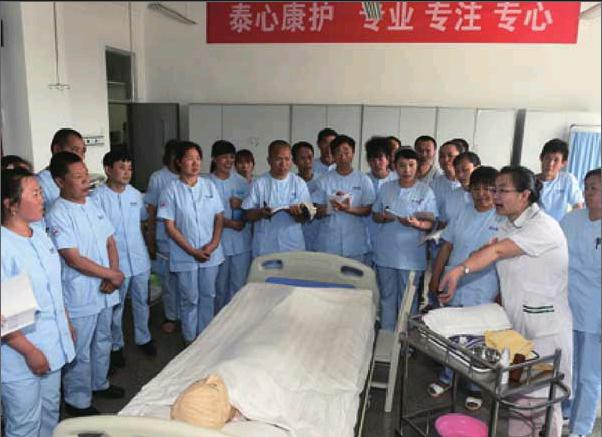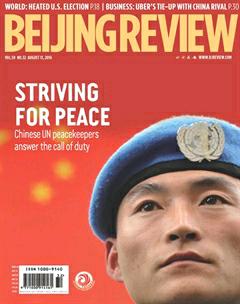Breaking the Cycle Of Despair
2016-09-12ByWangHairong
By+Wang+Hairong

Yang Xitai was a happy man. His 23-yearold son, Yang Jie, had graduated and was waiting on a prime job offer from one of the local banks. It seemed after years of struggle that life had taken a turn for the better.
And then tragedy struck the family in a rural area in central Chinas Henan Province.
On June 3, Yang Xitai noticed that his son seemed excessively pale after playing basketball and advised him to see a doctor
Two days later, Yang Jie went to the hospital, where laboratory tests showed that his platelet levels had dropped to zero. He was later diagnosed with a severe form of aplastic anemia, and was hospitalized for treatment.
Yang Jies bone marrow has stopped making blood cells. Because no suitable marrow was available for transplantation, doctors decided to treat him with medicine. The therapy is ongoing and expected to be lengthy and expensive. But after successful treatment, Yang Jie should once again be able to live a normal life, the doctors said.
Yang Jies medical insurance bought at the university he attended in Chongqing expired on graduation. He had not bought any other insurance. His mother, Du Hongxian, said that to save her son, the family has sold all their valuables, and currently about 900,000 yuan ($134,800) is needed for therapy.
The valuables included the taxi that Yang Xitai depended on to make a living, which was sold for 210,000 yuan ($31,450) along with its business license.
On June 29, the job offer from the local bank arrived, but sadly Yang Jie had to reject it. “A promising life is waiting for him, and I do not want to see him leaving this world,”Yang Xitai told Henan-based paper Dahe Daily.
In a desperate cry for help the family is seeking social assistance. “If someone would like to pay the medical bills to save my son, I would work for them for free the rest of my life,” Yang Xitai said.
So far, the family is still working to raise the funds needed to treat Yang Jie.
Health insurance
“In every family, as long as one member is ill and loses the ability to work, they have no way to increase family income, so the familys savings will be used to treat their disease,” said Hong Tianyun, Deputy Director of the State Council Leading Group Office of Poverty Alleviation and Development.
Hong spoke of his findings made during visits to poverty-stricken areas at a press conference held on June 21. He said that a chronic disease can trap a whole family in poverty.
China is taking a targeted approach to tackle poverty. An archive has been created for every impoverished household since the second half of 2015. Archive data reveal that 44.1 percent of all those households are heavily indebted because of huge medical expenses, Hong said.
In the 1980s and 1990s, rural residents were barely covered by medical insurance. The predicament of rural families was vividly portrayed in a ballad—“A ride in an ambulance, a swine raised in vain; one day in hospital, three years of savings gone; a serious disease, 10 years of hard work washed down the drain.”
In October 2002, the government released policies to step up rural health work, including the establishment of a new rural cooperative medical scheme. Since 2003, the government has allocated funds for the health insurance program.
This year, various levels of government subsidize 420 yuan ($63) for each partici- pant of the new rural cooperative medical scheme, said Wang Peian, Vice Minister of the National Health and Family Planning Commission, at the press conference on June 21. Individuals in provinces such as Henan and Jiangxi pay a 120-yuan ($18) premium, according to information on local government websites.
Under the new rural cooperative medical scheme, outpatients and inpatients can respectively get 50 and 75 percent of the eligible medical expenses reimbursed, Wang said.
Moreover, a policyholder can get an additional 10-15 percentage points of their medical expenses incurred by critical illnesses reimbursed, according to Wang. He said that the critical illness insurance is offering universal coverage, directly benefiting 3.45 million people.
Xiang Junbo, Chairman of the China Insurance Regulatory Commission, cited an example of a girl benefiting from the insurance at a press conference in March.
He said that in 2015, a girl from a rural area of Tongshan County in central Chinas Hubei Province was diagnosed with leukemia, and a bone marrow transplant cost her 1 million yuan ($150,000). The payout from the basic health insurance program covered 10 percent of the medical bill, and the payout from the critical illness insurance program covered another 70 percent, which saved the family from being plunged into poverty, Xiang said.
Assistance measures
To further alleviate poverty, on June 22, 15 central government departments jointly released a document on implementing programs to alleviate illness-induced poverty. It put forward five major measures to be implemented by the end of this year.
The government will subsidize the poverty-stricken rural population for the part of the health insurance premium required to be paid by individuals, and raise the level of benefits, according to the document.
All the rural poor will have access to medical assistance for serious illnesses, and more temporary and charitable assistance will be given to people with sudden, serious diseases who have difficulty in meeting basic needs and cannot receive family support.
Greater efforts will be made to treat the impoverished rural population with critical and chronic diseases. Those who receive treatment in designated hospitals in their counties only need to pay the out-of-pocket expenses upon release, while the part of expenses covered by health insurance will be paid from insurance benefits.
In poverty-stricken regions, at least one clinic will be set up in every village, one health center in every town, and one public hospital in every county. Prestigious hospitals nationwide will be paired up with hospitals in impoverished areas to offer assistance. More training will be delivered to medical workers in those areas.
In addition, medical and disease prevention work in poverty-stricken areas will be stepped up. More efforts will be made to prevent infectious diseases, endemics and chronic diseases. The government will launch a series of free-of-charge programs, including medical checkups for pregnant women, the screening of women for breast and cervical cancer, the improvement of childrens nutritional status and the screening of newborns for birth defects. There will also be campaigns to improve the sanitary conditions of rural areas and raise rural residents health awareness.
Wang said that health services in such areas are still inadequate. As of 2015, in 832 counties on the Central Governments poverty relief list, the number of hospital beds per thousand people was 3.66 and the number of practicing(or assistant) physicians per thousand people was 1.28, far below the national average.
Now, quality medical resources are be- ing mobilized to support poverty-stricken areas. For instance, from June 30 to July 3, more than 20 experts from Peking University Health Science Center visited Midu County in southwest Chinas Yunnan Province to offer assistance. The experts visited local hospitals, tutoring medical workers there and offering free medical services to patients. They also held training sessions on clinical research, nursing skills and hospital infection control. Some of them also gave lectures to local residents on topics such as tumor prevention, psychological self-adjustment, health and nutrition, and healthy lifestyles.
In addition, many organizations and individuals also actively support and participate in programs to alleviate illness-induced poverty. “In the past 30 plus years, civic groups have played a great role in implementing health-related poverty relief programs in rural areas,” Hong said.
He added that many programs have been launched by various social organizations and individuals to prevent and control endemics, congenital heart diseases and children amblyopia, and remarkable progress has been made.
